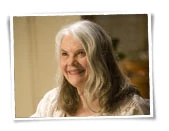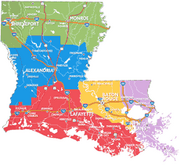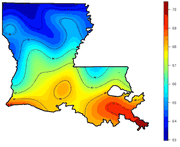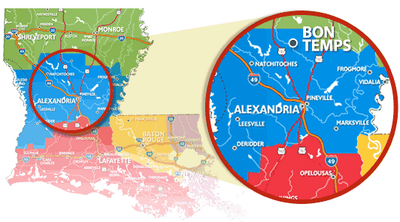[[:Category:{{{Images}}}|Images]]
WelcometoBonTemps.com, created by Twentieth Century Fox, was one of seventeen official companion websites that were created to complement the content found on the HBO original series True Blood.
Premise[]
The site was an introduction to the town of Bon Temps, Louisiana.
Version 1: 2009 - 2014[]

From the Louisiana Tourist Board and winner of the AVL Tourist Award, the first version of the site was introduced in 2009. Giving an account of the life and times of Bon Temps residents, WelcometoBonTemps.com is the official website of the town of Bon Temps.
- In addition to the link to go back to the homepage, there were five sections on the site. "Meet the Locals" introduced the viewer to major characters that live in Bon Temps. "How to get here" includes directions to Bon Temps. "Things to do" list many of the fine things that can be done, socially, recreationally, or otherwise. "Louisiana" gives detailed information about the state in which Bon Temps resides. "Cajun culture" gives background on the culture used in central Louisiana.
- The main page contains a Weather Channel forecast box for "Jonesboro, LA" with "Bon Temps, LA" appearing above Jonesboro in a larger font.
- There are three smaller entries below the main body of the main page. "Bar & Club Reviews", "Featured Events", and "Local Classified Ads"
Archives[]
Visit Us! Bon Temps, everbody wants a taste. Your senses will reach their potential in Louisiana. Start planning your trip today and come see, hear, taste smell and feel Bon Temps for yourself.
Our town is regarded as a wonderful place to visit, and one of Louisiana’s best. We possess a rich, unique and authentic culture which is admired throughout the world. We are the home of swamps, plantations and of course all kinds of pie. We are a tight community offering local history and experiences for every taste. We want to invite you to come and enjoy the things we do every day. There is nothing we love more than having company. We look forward to seeing you soon.
"Get to know some of the colorful personalities that makes Bon Temps a unique town." The Meet the Locals image linked to the "Meet the Locals" page.
See Bon Temps for yourself

Bon Temps' Testimonials
Residents of Bon Temps, Louisiana share their thoughts on Vampires coming to their small town.
Meet the Locals[]
Locals Speak Out[]

Bon Temps' Testimonials
Residents of Bon Temps, Louisiana share their thoughts on Vampires coming to their small town.

Sookie Stackhouse
A waitress who works at Merlottes, Sookie is telepathic and has a crush on a vampire. Word on the street is that her boss Sam Merlotte has a thing for this sassy waitress. Sookie lives with Bon Temps staple and grandmother Adele after her parents died in a car crash.

Jason Stackhouse
Some would say the town hunk, others say trouble on legs. Gossip travels fast here in Bon Temps and Jason is known to work his way through every attractive woman, even ones who are married. A charmer he might be but steer clear of this one.

Bill Compton
Bon Temps resident Vampire Bill is something like 173 years old! He fought in the civil war and returned to his family home in an attempt to become mainstream. He’s been spotted courting Sookie Stackhouse. He’s supposed to be harmless but some of the locals aren’t convinced. If you’re not one to drink with the undead then best to avoid Merlotte’s after-hours.

Sam Merlotte
Sam is quite a private guy but as owner and operator of the local watering hole, he holds a front-row seat to all the small-town drama of Bon Temps. You might catch Sam sleep walking naked every now and again and don’t be afraid of the dog that always hangs around his bar when its closed. We’re pretty sure it belongs to Sam.

Lafayette Reynolds
Lafayette is the eyes and ears of Bon Temps. He knows just about everything there is to know about everyone. He’s Merlotte’s short-order grill cook but he’s definitely got his hands dipped in many shady sideline businesses. Some locals say he accepts sexual favours in exchange for V-blood.

Tara Thornton
If you hear a loud, cursing voice working behind the bar at Merlotte’s, that’s Tara. Don’t worry her bark is worse than her bite. She built up a tough exterior taking care of her alcoholic mother. Tara is Sookie’s best friend but she also has a soft spot for her brother Jason.

Andy Bellefleur
Andy is the town’s detective, although no one ever really takes him seriously. He has it in for Jason Stackhouse and he still lives at home with his sister and grandmother. The poor guy can’t seem to find a nice girl to settle down with and has been a resident of Bon Temps for about as long as the Stackhouses.

Rene Lenier
Shacked up with Arlene Fowler, a stand-up guy, holds a steady job, wants kids some day...Rene seems almost too good to be true. He is from out of town after all.

Arlene Fowler
If you want a secret spread, Arlene is your gal. She’s divorced with kids and is dating a friend of Jason’s, Rene Lenier. The poor woman is in denial that she’s pushing forty and is always left frazzled for some reason or another.

Adele Stackhouse
Known as the town’s Gran, she’ll open her door to just about anyone and offer you a slice of pie and fresh lemonade. Adele took young Sookie in after her parent’s died and runs the Civil War Group at the local church.
How to get here[]
|
From New Orleans:
|
From Baton Rouge:
|
Things to do[]
TOP 10 THINGS TO DO
1. Eat
Bon Temps is famous for its late night barbeques. Bon Temps offers open –hearth cooking demonstrations that reveal 19th century kitchen secrets, such as how to spit-roast meat over a wood-burning fire.
2. Drink
Imported from as far as Japan, Bon Temps is known for its speciality and synthetic drinks.
3. Hang
Join the locals at Merlotte’s, Bon Temps favourite dinner. There’s nothing like a long weekend road trip to immerse yourself in Louisiana music, sampling the state’s sonic riches.
4. Tour
Go to the amazing Cajun country. The Chalmette battlefield, where the battle guaranteeing our independence took place, may be the single most important military memorial in the country.
5. Dip
Enjoy one of Bon Temps’ murky swamps.
6. Sleep (if you must)
Take a quick nap in one of Bon Temps typically southern plantation guest houses.
7. Shop
Buy a loved one a silver necklace from the Arts and Crafts fair.
8. Foresee
Have your future told by Bon Temps’ very own witch doctor.
9. Chat
Join in on the fascinating discussions with Bon Temps’ Civil War group at the local church.
10. Walk ...
...amongst the dead – Bon Temps cemetery is one of the oldest in Louisiana.
Louisiana[]
Overview & Demographics[]
|
Official languages: |
Population: |

As of July 2005 (prior to the landfall of Hurricanes Katrina and Rita), Louisiana has an estimated population of 4,523,628. The center of population of Louisiana is located in Pointe Coupee Parish, in the city of New Roads. The five largest ancestries in the state are: African American and Franco-African (32.5%), French / French Canadian (16.2%), American (10.1%), German (7.1%), Irish (7%) and Italian (4.4%). Louisiana is home to the second-largest proportion of black Americans (32.5%) in the United States, behind neighboring Mississippi (36.3%). Franco-Africans and African-American blacks dominate much of the southeast, central, and northern parts of the state.
Cajuns and Creoles of French ancestry are dominant in much of the southern part of the state. Louisiana Cajuns are the descendants of French-speaking Acadians from colonial French Acadia, which are now the present-day Canadian provinces of New Brunswick, Nova Scotia and Prince Edward Island. The creole population also includes people of Spanish ancestry, most notably “Isleños” of Canary Islander ancestry, who live along the southern Gulf coast.
Whites of Southern U.S. background predominate in northern Louisiana. These people are predominantly of English, German, Welsh, and Scots Irish backgrounds, and share a common, mostly Protestant culture with Americans of neighboring states.
History[]
Louisiana was inhabited by Native Americans when European explorers arrived in the 16th century. The state has been governed under 10 different flags beginning in 1541 with Hernando de Soto's claim of the region for Spain.
Many place names in the state are transliterations of those used in Native American dialects. In the late 17th century, French expeditions established a foothold on the Mississippi River and Gulf Coast. In 1682, the French explorer Robert Cavelier de La Salle named the region Louisiana to honor France's King Louis XIV. The French colony of Louisiana originally claimed all the land on both sides of the Mississippi River and north to French territory in Canada.
Recognizing the importance of the Mississippi River to trade and military interests, France made New Orleans the seat of civilian and military authority in 1722. From then until the United States acquired the territory in the Louisiana Purchase on December 20, 1803, France and Spain traded control of the region's colonial empire.
During the period of Spanish rule, several thousand French-speaking refugees from the region of Acadia (now Nova Scotia, New Brunswick, and Prince Edward Island, Canada) made their way to Louisiana following British expulsion after the Seven Years' War. They settled chiefly in the southwestern Louisiana region now called Acadiana. The Spanish, eager to gain more Catholic settlers, welcomed the Acadian refugees. Cajuns descend from these Acadian refugees. In 1800, France's Napoleon Bonaparte acquired Louisiana from Spain in the Treaty of San Ildefonso, an arrangement kept secret for two years.
Thomas Jefferson, third President of the United States, was disturbed by Napoleon's plans to re-establish French colonies in America. With the possession of New Orleans, Napoleon could close the Mississippi to U.S. commerce at any time. Jefferson authorized Robert R. Livingston, U.S. Minister to France, to negotiate for the purchase of the City of New Orleans, portions of the east bank of the Mississippi, and free navigation of the river for U.S. commerce. However, on April 11, 1803, French Foreign Minister Talleyrand surprised Livingston by asking how much the United States was prepared to pay for the entirety of Louisiana, not just New Orleans and the surrounding area. With the acquisition of Louisiana, Jefferson nearly doubled the size of the United States overnight.
Through much of its early history Louisiana was a trading and financial center, and the fertility of its land made it one of the richest regions in America as first indigo then sugar and cotton rose to prominence in world markets. Many Louisiana planters were among the wealthiest men in America. The plantation economy was shattered by the Civil War although the state continued to be a powerful agricultural region. The discovery of sulphur in 1869 and oil in 1901, coupled with the rise of forestry sent the state on a new wave of economic growth. Eventually, Louisiana became a major American producer of oil and natural gas and a center of petroleum refining and petrochemicals manufacturing, which it remains to this day.
Climate[]

Louisiana has a relatively constant semitropical climate, with long, hot, humid summers and short, mild winters. Those parts of the state that are in close proximity to the Gulf of Mexico tend to be very humid with lots of rainfall, and little difference between summer and winter conditions. Summers in Louisiana are hot and humid, with high temperatures from mid-June to mid-September averaging 90 °F (32 °C) or more and overnight lows averaging above 70 °F (22 °C). In the summer, the extreme maximum temperature is much warmer in the north than in the south.
Louisiana is prone to hurricanes (June is the start of hurricane season), with the most severe being the recent Hurricanes Rita and Katrina in 2005. Required clothing: lightweight cotton clothing for summer, with sweaters and jackets for winter. Rainwear or an umbrella is advised for all seasons.
Languages[]
Louisiana has a unique linguistic culture, owing to its French and Spanish heritage. n 2000, 3,771,003 Louisiana residents—90.8% of the population five years old and older (up from 89.9% in 1990)—spoke only English at home. Unique to Louisiana is a large enclave, west of New Orleans, where a variety of French called Acadian (Cajun) is the first language: 4.7% speak French at home (7% total speak French). Other minority languages are Spanish and German.
Religions & Music[]
Religions[]
Until the Louisiana Purchase, the public practice of any but the Catholic religion was prohibited, and Jews were entirely banned. As of 2000, the Roman Catholic Church was the largest Christian denomination, with 1,382,603 church members. The leading Protestant denominations were the Southern Baptist Convention, 768,587; the United Methodist Church, 160,153; Assemblies of God, 49,041; and the Episcopal Church, 33,653. There were about 16,500 Jews residing in Louisiana in 2000, a majority of them in New Orleans. The Muslim community had about 13,050 members. Voodoo, in some cases blended with Christian ritual, is more widespread in Louisiana than anywhere else in the United States.
Music[]
The music of Louisiana can be divided into three general regions. The Acadiana region of the state (Southern Louisiana, west of New Orleans) is dominated by Cajun culture. To the southeast, the region in and around Greater New Orleans has a unique musical heritage tied to Dixieland jazz, blues and Afro-Caribbean rhythms. The northern portion of the state starting at Baton Rouge shares the similarities with the rest of the US South. Cajun music is very similar to Creole music. It was rooted in the music of the French-speaking Catholics of Canada and became transformed into a unique sound of the Cajun culture. In earlier years of the late 18th century the fiddle was the predominant instrument and the music tended to sound more like early country music. Cajun music is typically a waltz or two step.
The northern region has not led to a development of a "local" music. Traditional and modern country music has been dominant, creating its own country stars, like Tim McGraw, Jimmie Davis, Trace Adkins, and Andy Griggs. Northern Louisiana in the 1950s had a country rock scene, many of whose artists were recorded by local Ram Records. Later, Shreveport produced The Residents, Kenny Wayne Shepherd, Private Life featuring Danny Johnson, now a member of Steppenwolf, and Sunday Mass Murder.
Cajun culture[]
Overview[]
Cajuns are an ethnic group consisting of the descendants of Acadian exiles and peoples of other ethnicities with whom the Acadians eventually intermarried on the semitropical frontier. Today, the Cajuns make up a significant portion of south Louisiana's population, and have exerted an enormous impact on the state's culture.
The word "Cajun" comes from the French pronunciation of Acadian (in French, the masculine Acadien, the feminine Acadienne) which is "A-Cad-jin" or "Cajin" which then became "Cajun". Acadia was the name given to lands in a portion of the French colonial empire in northeastern North America that included parts of eastern Quebec, the Maritime provinces, and modern-day New England, stretching as far south as Philadelphia.
The Cajuns retain a unique dialect of the French language and numerous other cultural traits that distinguish them as an ethnic group. Cajuns were officially recognized by the U.S. government as a national ethnic group in 1980 per a discrimination lawsuit filed in federal district court.
Cuisine[]

Cajun cuisine developed out of necessity, since the Acadian refugees had to learn to live off the land and adapted their French rustic cuisine to local ingredients such as rice, crawfish, and sugar cane. Feeding a large family, all of whose members did hard physical work every day, required a lot of food. Cajun cuisine grew out of supplementing rice with white meat, game or other proteins where available such as crawfish or any other type of river creature. An authentic Cajun meal is usually a three-pot affair, with one pot dedicated to the main dish, one dedicated to steamed rice, skillet cornbread, or some other grain dish, and the third containing whatever vegetable is plentiful or available.
The aromatic vegetables bell pepper, onion, and celery are called by some chefs the holy trinity of Cajun cuisine. Finely diced and combined in cooking, the method is similar to the use of the mire poix in traditional French cuisine — which blends finely diced onion, celery, and carrot. Characteristic seasonings include parsley, bay leaf, "green onions" or scallions, and dried cayenne pepper. The overall feel of the cuisine is more Mediterranean than North American.
Dishes[]
Gumbo[]
Gumbo is a full body and flavorful soup or stew. It exemplifies the influence of African and Native American food cultures on Cajun cuisine. Gumbo typically consists of two components, rice and broth, and because to the cooking time and effort it is typically made in large batches. A filé gumbo is thickened with sassafras leaves after the gumbo has finished cooking, a practice borrowed from the Choctaw Indians. The backbone of a gumbo is a dark roux, which is made of flour, toasted until well browned, and fat or oil, not butter as with the French. The classic gumbo is made with chicken and the Cajun sausage called andouille, but the ingredients all depend on what is available at the moment.
Boudin[]
It is a type of sausage made from pork, pork liver, rice, garlic and green onion, and other spices. It is widely available by the link or pound from butcher shops. Boudin is typically stuffed in a natural casing and has a softer consistency than other, better-known sausage varieties. It is usually served with side dishes such as rice dressing, maque choux, or bread.
Jambalaya[]
Another classic Cajun dish is jambalaya. The only certain thing that can be said about a jambalaya is that it contains rice and almost anything else. Usually, however, one will find green peppers, onions, celery and hot chili peppers.
Idioms[]
Cajun French is one of three varieties or dialects of the French language spoken primarily in the U.S. state of Louisiana, specifically in the southern parishes. Other Louisiana French dialects include Napoleonic French and Colonial or Plantation Society French, spoken primarily in the parishes of Orleans, St. Bernard, St. Charles, St. John the Baptist, Jefferson, West Baton Rouge, Pointe Coupée, Avoyelles, St. Mary, Iberia, Assumption, and St. Landry. Cajun French is not the same as Louisiana Creole. It is usually presumed that Cajun French is almost solely derived from Acadian French as it was spoken in the French colony of Acadia. Cajun differs from Metropolitan French in pronunciation, vocabulary and intonation.
English is now spoken by the vast majority of the Cajun population, but French influence remains strong in terms of inflection and vocabulary, and the accent is quite distinct from the General American.
Religious traditions[]
Cajuns are predominantly Roman Catholic. However, Protestant and Evangelical Christian denominations have made inroads among Cajuns, but not without controversy — many Cajuns will shun family members if they convert to any form of Protestantism because of the extreme persecution the Cajuns were subjected to by Protestants during the Great Expulsion of 1755, and throughout their history for maintaining their Catholicism.









